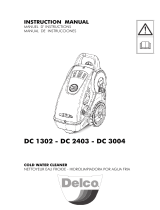
4
CLASSIFICATION OF RISKS:
Identifies an imminent risk which could lead to
serious or fatal injury.
Danger
Identifies a risk situation which could lead to
serious injury.
Warning
Identifies a risk situation which could lead to
minor injury or damage to things.
Information
PREFACE
You must read this manual before installing,
starting up and using the high pressure washer.
This manual is an integral part of the product.
Warning
Read the warnings and instructions contained in
the manual carefully as they provide important
information on USER SAFETY and MAINTENANCE,
paying particular attention to the general safety
regulations.
KEEP THIS MANUAL IN A SAFE PLACE FOR
FUTURE REFERENCE.
Those operating and servicing the high pressure
washer must be aware of the contents of this
manual.
Warning
CLASSIFICATION
The user must observe the conditions of use of the
appliance prescribed by the Rules, and particularly he
must respect the following classification:
As for the protection against electric shock, the H.P.cleaner
belongs to CLASS I.
The H.P. cleaner is factory set and all its safety devices
are sealed. It is forbidden to alter their adjustment
values.
In the Hot water cleaner the water is heated by a burner
feed with Diesel fuel.
The H.P. cleaner must be always used on a firm and flat
ground, furthermore it must not be moved while it is
working or connected to the electric supply.
Failure to observe this prescription may cause danger for
the user.
The H.P. cleaner must not be used in the presence of
corrosive or potentially explosive atmospheres.
(vapours or gas)
GENERAL SAFETY RULES FOR
THE USE OF HIGH PRESSURE
CLEANERS
- The electric connection must be performed by
qualified technicians who are able to work in
observance of the governing rules (in compliance
with the provisions of the IEC 60364-1 standard)
and of the manufacturer’s instructions.
A wrong electric connection may cause damage
to persons, animals or things, and the
manufacturer cannot be considered responsible
for these.
- The H.P. cleaners with power lower than 3 kW
are equipped with a plug for connection to the
electric supply.
In this case please check if the electric power
system and the electric sockets are compatible
with the max. power of the appliance indicated
on the plate. (kW).
In case of doubt, please apply to qualified
personnel. If the socket and the plug of the
machine are not compatible, have the plug
replaced with a suitable type by qualified
personnel.
- Before connecting the machine make sure
that the data indicated on the plate correspond
to those of the electric supply.
- Do not use extensions to power the high
pressure washer.
If you use an extension, the plug and socket
must be watertight. Unsuitable extensions may
be dangerous.
- The electric safety of this machine may be
assured only when it is properly connected to
an efficient grounding system in accordance with
the governing laws for electric safety. (In
compliance with the provisions of the IEC 60364-1
standard)
Warning


















